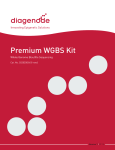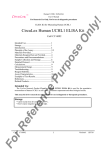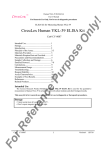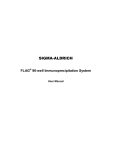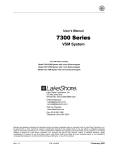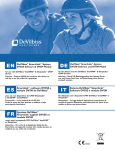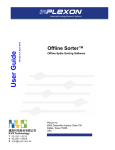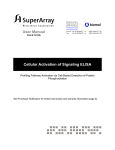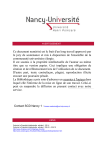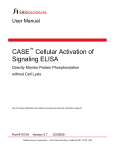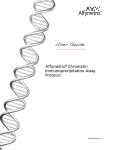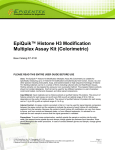Download CHP2 - Bulletin - Sigma
Transcript
User Guide Catalog No. CHP2 ® Imprint Ultra Chromatin Immunoprecipitation Kit sigma-aldrich.com/life-science/epigenetics/chip2.html Imprint® Ultra Chromatin Immunoprecipitation Kit Table of Contents CHP2 Kit Components and Storage ...........................................................................................................2 Product Description..............................................................................................................................................3 CHP2 is Designed for ChIP-Seq......................................................................................................................3 Staph A DNA Contamination is Reduced Using ChIP Next Gen Seq Sepharose................4 Workflow.....................................................................................................................................................................4 Bridging Antibody Requirement, and Stability......................................................................................5 Reagents and Equipment Recommended But Not Provided.......................................................5 Preparation Instructions.....................................................................................................................................6 Table 1: Guidelines for Cell Number Requirements...................................................................6 Critical Parameters for ChIP-Seq.....................................................................................................................7 Experimental Design............................................................................................................................................7 Procedure...................................................................................................................................................................8 Section 1. Blocking ChIP Next Gen Seq Sepharose....................................................................8 Section 2. Preparation of Cross-linked Cells...............................................................................8-9 Section 3. Preparation of Cross-linked Chromatin...............................................................9-10 Section 4. Pre-clearing of Cross-linked Chromatin.................................................................. 11 Section 5. Antibody Binding................................................................................................................ 11 Section 6. Bridging Antibody and IP................................................................................................ 12 Section 7. Washings.................................................................................................................................. 13 Section 8. ChIP Elution............................................................................................................................ 13 Section 9. Cross-link Reversal............................................................................................................... 13 Section 10. DNA Purification................................................................................................................ 14 Section 11. Q-PCR Assays...................................................................................................................... 14 Section 12. Data Analysis....................................................................................................................... 15 Section 13. Expected Results............................................................................................................... 16 Section 14. Preparation for ChIP-chip............................................................................................. 16 Section 15. Preparation for ChIP-Seq .............................................................................................. 16 References .............................................................................................................................................................. 16 Troubleshooting Guide..............................................................................................................................17-18 Appendix................................................................................................................................................................. 19 Chromatin Sonication Optimization.................................................................................19 Cross-link Reversal and DNA Purification.................................................................19-20 Application Data (Figs. 3-9)......................................................................................................20-24 1 CHP2 Kit Components and Storage CHP2 kits are shipped at two different temperatures. The wet ice shipment contains Parts 1 and 2. The dry ice shipment contains Part 3. Storage temperatures are indicated below: Reagent Description Catalog Number CHP224 Rxn CHP2NC48 Rxn Part 1, stored at room temperature (RT) ChIP Next Gen Seq Sepharose ® S6576 3 tubes 5 tubes Dialysis Buffer B6063 55 mL 110 mL Cell Lysis Buffer B5938 6 mL 12 mL Igepal CA-630 Mol. Bio. Grade* I8896 1 mL 1 mL Nuclei Lysis Buffer* B6438 3 mL 6 mL IP Dilution Buffer* B6188 10 mL 20 mL IP Wash Buffer* B6313 110 mL 220 mL Sodium Bicarbonate Solution, 1 M S6326 150 µL 300 µL Sodium Dodecyl Sulfate Solution, 10 % 71736 1 mL 1 mL Water Mol. Bio. Reagent W4502 50 mL 50 mL Sodium Chloride, 5 M Solution Mol. Bio. Grade S5150 1.5 mL 1.5 mL CHP2 DNA Purification Columns C6874 35 ea 70 ea CHP2 DNA Purification Collection Tubes T5205 35 ea 70 ea CHP2 DNA Binding Buffer B5563 35 mL 70 mL CHP2 DNA Wash Buffer** B5813 6 mL 6 mL CHP2 DNA Elution Buffer B5688 10 mL 10 mL Albumin, Bovine, Globulin Free A7638 250 mg 250 mg Glycine Solution, 1.25 M G7173 30 mL 2 x 30 mL Rabbit Immunoglobulin G (IgG), From Serum I5006 1 mg 1 mg Mouse Immunoglobulin G (IgG), From Serum I5381 1 mg 1 mg Deoxyribonucleic Acid, Single Stranded from Salmon Testes D9156 1 mL 1 mL 4-(2-Aminoethyl) Benzenesulfonyl Fluoride (AEBSF) A8456 2 x 25 mg 100 mg Protease Inhibitor Cocktail (PIC) Without Metal P8340 1 mL 1 mL Ribonuclease A Solution Mol. Bio. Grade R4642 10 mg 10 mg Part 2, stored at refrigerator temperature (2-8 ˚C) Part 3, stored at freezer temperature (-20 ˚C) M7023 60 µL 60 µL WH0005430M1 8 µg - Human Actin Positive Control Primer Set, 5 μM A8611 50 µL - Human ZNF333-3' Negative Control Primer Set, 5 μM Z4027 50 µL - Anti-Mouse IgG (Whole Molecule) Monoclonal Anti-POLR2A * These reagents should be warmed up to room temperature for 15 minutes before use in order to dissolve any detergents that may have precipitated during shipping. Warm and mix to obtain a clear solution before use. ** Add 24 mL Ethanol (459844, not provided) to the DNA Wash buffer concentrate (B5813, Part 1, RT) before use. 2 Product Description The Imprint® Ultra Chromatin IP Kit is Sigma’s second generation chromatin immunoprecipitation (ChIP) kit developed for maximum sensitivity and optimum next-generation sequencing results. This kit uses modified Staphylococcus aureus (Staph A) to immunoprecipitate and purify chromatin complexes. Sequencing quality modified Staph A (ChIP Next Gen Seq Sepharose) is achieved by employing a proprietary DNA-blocking technology to prevent Staph A DNA contamination of next-generation sequencing data in ChIP-Seq experiments. The DNA-blocked “ChIP Next Gen Seq Sepharose” cells are ideally suited for studying recruitment of low abundance transcription factors (TF) in genome wide location analysis experiments such as ChIP-chip and ChIP-Seq. The high surfacedensity of endogenous protein A on the cell wall of Staph A serves as an excellent matrix to pull-down rare TF-associated chromatin complexes. The high protein A binding capacity coupled with a very stringent wash buffer improves the sensitivity and specificity of the Imprint Ultra ChIP kit resulting in high yields of pure DNA with extremely low backgrounds. This development will now allow researchers to explore the genome-wide binding sites of low abundance TF’s as well as novel histone modifications. The Imprint Ultra ChIP protocol has been adapted from, and validated in consultation with, the laboratory of Dr. Peggy Farnham, USC Los Angeles. It is optimized for ChIP reactions with chromatin from 10 million cells (up to ≈ 50 μg DNA), and can also be scaled up (or several preparations pooled) to accommodate 108 cells for genome-wide binding studies in ChIP-chip and ChIP-Seq applications. Our ChIP Next Gen Seq Sepharose DNA-blocking treatment prevents blocked Staph A DNA from participating in any PCR-based amplification reactions, thereby virtually eliminating Staph A DNA contamination of Illumina-libraries prior to massively parallel nextgeneration sequencing (Figs.1-2). The blocking treatment does not alter the performance of ChIP Next Gen Seq Sepharose in ChIP-Seq assays (Figs.4-5 in Appendix). This breakthrough results in dramatic improvement of the number of sequence reads that map back to the genome of interest in a BLAST search against the reference genome. Successful performance of the Imprint Ultra ChIP kit has been demonstrated in a ChIP-Seq experiment performed in collaboration with the Farnham lab (Palhan, et al., manuscript in preparation). ChIP was performed using 200 million DU145 cells and an EZH2 antibody (a low abundance transcription factor) using either untreated (C) or ChIP Next Gen Seq Sepharose (T) cells (Fig.4 in Appendix). We have demonstrated a 23 % gain in correct mapping of sequence reads obtained using ChIP Next Gen Seq Sepharose vs untreated Staph A from the EZH2 ChIP libraries. This resulted in discovering 5 million additional unique sequences where EZH2 was captured from DU145 cells using ChIP Next Gen Seq Sepharose vs standard Staph A cells (Fig.6 in Appendix). Thus we have developed a unique procedure to block the Staph A DNA while retaining the functionality of ChIP Next Gen Seq Sepharose in ChIP-Seq applications. CHP2 is Designed for ChIP-Seq Fig. 1 Use of untreated (top panel) Staph A (blue circle) in a ChIP-Seq assay results in Staph A DNA sequences (red) contaminating the genomic ChIP’ed DNA sequences (green) of interest. Both the genomic DNA and the Staph A DNA are amplified in the Illumina library. Employing DNA-blocked ChIP Next Gen Seq Sepharose (lower panel) practically eliminates Staph A DNA contamination in Illumina-Sequencing data. 3 1448 Fold Reduction in DNA Leakage from Staph-Seq 1600 Fold Reduction in Staph A DNA 1400 1200 1000 800 600 400 200 0 Staph A Staph-Seq Fig. 2 Staph A DNA contamination is reduced using ChIP Next Gen Seq Sepharose. Chips were performed using ChIP Next Gen Seq Sepharose versus untreated Staph A control cells and then analyzed using primers targeting Staph A rDNA. A 1448 fold reduction in Staph A DNA contamination (a 10.5 Ct difference) was observed using Workflow Cross-Link Cells in Suspension Prepare Nuclear Lysate Sonicate Chromatin Reverse XL, Determine DNA Concentration and Size Range Block Staph-Seq Preclear Chromatin IP Stringent Washes Elute IP Complexes Cross-Link Reversal Column DNA Purification Elute DNA qPCR WGA Library ChIP-chip ChIP-Seq 4 Bridging Antibody Requirement The protein A present on the surface of ChIP Next Gen Seq Sepharose binds efficiently to antibodies derived from rabbits. For ChIP assays with antibodies derived from other animals, such as monoclonals (from mouse), rat, chicken, etc. an appropriate bridging antibody (raised in rabbits) should be used as instructed in the protocol. A rabbit anti-mouse Ab (M7023) is provided in the kit for bridging mouse monoclonal antibodies. Users planning to ChIP with antibodies raised in animals other than rabbit or mouse are advised to procure the appropriate bridging antibody separately. Control Antibody and Primers The positive control antibody provided in the CHP2 kit, Monoclonal Anti-POLR2A, recognizes human and mouse RNA polymerase II A. For other species, the user will need to identify their own positive control. In addition, the positive and negative control Primer Sets provided in the kit (Actin Positive Control Primer Set and ZNF333-3’ Negative Control Primer Set) are human-specific. Recommended primer sequences for rat and mouse can be found on the Sigma-Aldrich CHP2 website. Precautions and Disclaimer This product is for R&D use only, not for drug, household, or other uses. Please consult the Material Safety Data Sheet for information regarding hazards and safe handling practices. Storage and Stability All components, if stored at the appropriate temperatures as suggested in the reagents table, are stable for up to 12 months. Care must be taken not to introduce DNases. We recommend the use of DNase-free pipette tips, preferably those having an aerosol barrier. Wear latex gloves and change them frequently. Keep bottles and tubes closed when not in use. Reagents and Equipment Recommended but Not Provided • • • • • • • • • • • • • • • • • • • • Positive and negative control primers, if using non-human cells or tissue ChIP-validated antibody to protein of interest, matching non-specific antibody or pre-immune serum Cells or tissue 0.25 % Trypsin-EDTA solution (T4049) Hank’s balanced salt solution, HBSS (H6648) Formaldehyde solution, 37 % in water (F8775 or 252549) Heat block or Oven capable of 67 ˚C, 100 ˚C and 37 ˚C Vortex Genie 2 or equivalent and microtube head set insert that can hold 0.5 mL and 1.5 mL tubes Refrigerated Microcentrifuge for 1.5 mL microcentrifuge tubes (capable of 16,000 x g) Rotating platform that can hold 0.5 mL and 1.5 mL tubes 1.5 mL screw-cap tubes (Corning 430909) Microcentrifuge tube holders (Z708372; optional) GenomePlex Complete Whole Genome Amplification (WGA) Kit, Cat. No. WGA2 (optional) GenomePlex WGA Reamplification Kit, WGA3 (optional) SYBR® Green JumpStart™ Taq ReadyMix™ (Component of S4438) Ethanol (459844) 10X Phosphate Buffered Saline (P7059) Sonicator – Diagenode BioRuptor™ recommended Polystyrene tubes for sonication in the BioRuptor™, 1.5 mL (Diagenode M-50050) and 15 mL (Falcon 352099) Proteinase K (P4850) 5 Preparation Instructions • Optimize shearing conditions for your cell type: The equipment and cell type used in preparing the sheared chromatin can have a significant impact on the success of the experiment. It is imperative that chromatin is completely sheared into smaller fragments with a peak around 500 bp for ChIP-qPCR assays and < 500 bp (See Fig. 3 in Appendix) for ChIP-Seq assays to increase specificity and ensure low background with a non-specific antibody (Rb/Mu IgG). The Imprint Ultra ChIP kit does not include sufficient reagent volumes to optimize shearing and also to perform all 24 or 48 ChIPs. We recommend using the companion Chromatin Sonication Optimization kit (Product # CHROP-15Rxn) to optimize the sonication/chromatin shearing conditions for each new cell or tissue type before performing ChIP. • Thoroughly mix reagents. Examine the reagents for precipitation. If any reagent has formed a precipitate, warm at 55 ˚C until dissolved. Allow to equilibrate to room temperature before use. • DNA Wash Buffer (B5813): Dilute the DNA Wash Buffer Concentrate (B5813, Part1, RT) with 24 mL of ethanol (459844, not provided) before first use. After each use, tightly cap the diluted DNA Wash Buffer to prevent the evaporation of ethanol. • Planning the ChIP experiment and chromatin/cell requirements: Depending on the relative abundance of the target DNAbinding protein [Transcription factor (TF), chromatin regulator/modifier or histone modification, DNA methylation] and the downstream DNA detection application, grow and cross-link the appropriate number of cells before starting to prepare the chromatin. See ChIP data for low-abundance (EZH2), medium-abundance (RNAP II) and high-abundance (H3K27me3) targets with chromatin from 10 million and 2 million cells to help determine your cell number requirements (Figs. 7-9 in Appendix). Follow the guidelines indicated in the table below: TF abundance Histone modification or abundant TF Medium abundance TF (e.g. RNAP II) Rare TF (Low abundance TF and co-activator/co-repressor that does not bind DNA directly e.g. EZH2) Application Number of cells qPCR 0.5 - 2 x 106 Microarray 104 - 106 Sequencing 105 – 107 qPCR 2-10 x 106 Microarray 105 – 106 Sequencing 106 – 107 qPCR 5-10 x 106 Microarray 50 x 106 (5 ChIPs) Sequencing 100-200 x 106 (10-20 ChIPs) Table 1: Guidelines for number of cells required, depending on the relative abundance of ChIP target and downstream application. If you are interested in performing ChIPs with fewer cells (104-105) we recommend following the MicroChIP protocol3 which is compatible with the reagents provided in this kit. The WGA DNA amplification kits will have to be purchased separately. For ChIP-chip: For genome-wide ChIP-chip studies of a rare TF like EZH2, we recommend performing 5 individual ChIPs with chromatin from 10 million cells each and pooling by purifying ChIP’ed DNA on one column. Concentrated ChIP’ed DNA can be eluted using a small volume (6-10 μL) of Elution buffer and used directly in WGA or labelling reactions. For ChIP-Seq: For ChIP-Seq studies of a rare TF like EZH2, we recommend performing 20 individual ChIPs with chromatin from 10 million cells each and pooling by purifying ChIP’ed DNA on one column. Concentrated ChIP’ed DNA can be eluted using a small volume (6-10 μL) of Elution buffer and used directly in the downstream library generation reaction as needed. 6 Critical Parameters for ChIP-Seq: • • • Chromatin from 100 – 200 million cells for rare TF (refer to Table 1) • • • ChIP-suitable antibody, optimized by ChIP-qPCR assays Chromatin sonicated to below 500 bp with a peak around 250 bp Block ChIP Next Gen Seq Sepharose with BSA. Do not add any foreign DNA, such as herring sperm or salmon sperm DNA, because any foreign DNA that is carried through the ChIP procedure and is eluted with the chromatin will be sequenced along with ChIP target DNA. The latter is especially a problem with ChIP-Seq for low abundance transcription factors, for which contaminating DNA sequences can contribute a high proportion of reads at the expense of ChIP target sequences qPCR primers to known transcription factor target and non-target regions to validate ChIPs before and after library preparation ChIP’ed DNA cross-link reversal by overnight incubation at 65 °C. Do not boil. Boiling denatures DNA and library preparation requires double-stranded DNA for adapter ligation. For highly abundant targets like ChIPs for histone modifications, performing Proteinase K treatment [by adding 1 µL of Proteinase K (P4850) and incubating at 65 °C for 1 hour] to ChIP eluates between steps 48 and 49 in the procedure may increase yields of ChIP’ed DNA Experimental Design: Refer to Table 1 for determining the chromatin requirement (from appropriate number of cells) depending on the relative abundance of target protein being ChIP’ed (TF/histone modification). For each TF ChIP assay you will need sonicated chromatin containing 20-50 μg DNA (determined by cross-link reversal of an aliquot of chromatin, followed by DNA quantification) or chromatin from 10 million human cells (≈ 125 μL following the procedures below) and 20 μL of ChIP Next Gen Seq Sepharose (10 μL each for preclearing and IP). Cell cultures should be healthy and not density arrested prior to cross-linking. Fewer cells, as low as 2 million per antibody per ChIP, can be used but may result in lower signal to noise ratio. We recommend the following design for each ChIP experiment: 1. 2. 3. 4. Chromatin + Mouse IgG (0.5 μL, negative control Ab for RNAPII ChIP, provided in the CHP2 kit with controls) Chromatin + RNAPII Ab (2 μL, positive control for ChIP; provided in the CHP2 kit with controls) Chromatin + IgG (negative control Ab or pre-immune serum provided by user) Chromatin + TF Ab (specific antibody to transcription factor of interest provided by user) Although the optimal amount for each antibody will need to be determined experimentally, 1 µg is a good starting point for most antibodies. Due to the high antibody binding capacity of ChIP Next Gen Seq Sepharose, we recommend titrating the antibody to determine the minimum amount of antibody required per ChIP for the highest signal to noise ratio. Note that the optimum amount of antibody needed for ChIP Next Gen Seq Sepharose ChIPs may be significantly less than the optimum for ChIPs with magnetic or agarose beads. Sufficient reagents are provided in the 24 Rxn kit (with controls) for 8 sets of positive control ChIP reactions that the user may set up alongside their antibody of interest. ChIP-Seq users are advised to use the 48 Rxn CHP2 kit without controls to acquire sufficient DNA for sequencing without pre-library prep amplification. 7 Procedure Section 1. Blocking ChIP Next Gen Seq Sepharose (The evening before you start the ChIPs) Pre-requisites: • • • • • Pre-cool microcentrifuge to 4 °C Reconstitute AEBSF (A8456, Part 3, -20 °C): add 1.04 mL water (W4502, Part 1, RT) to one of the two 25 mg bottles (24 Rxn kit) or 4.17 mL water to the 100 mg bottle (48 Rxn kit) to generate a 0.1 M stock. Mix and vortex until dissolved, and keep on ice. After use, store at -20 °C Reconstitute 250 mg BSA (A7638, Part 2, 4 °C) with 12.5 mL of water (W4502, Part 1, RT), mix by vortexing and inverting to make a 20 mg/mL solution and keep on ice. After use, make 1 ml aliquots and store at -20 °C Thaw sonicated salmon sperm DNA (D9156, Part 3, -20 °C) and keep on ice Prepare the required amount of blocked ChIP Next Gen Seq Sepharose (S6576, Part 1, RT) depending on the number of ChIP experiments planned within the next two weeks. You will need 20 μL of blocked ChIP Next Gen Seq Sepharose per ChIP reaction Note: For all subsequent steps requiring removing supernatant from ChIP Next Gen Seq Sepharose pellets, please aspirate gently with a P1000 or P200 pipette. DO NOT USE VACUUM TO ASPIRATE, as you may lose the ChIP Next Gen Seq Sepharose. Note: Do not allow pellets to dry out, add fresh wash buffer to each tube immediately after the previous wash buffer has been removed. For the set of four ChIPs recommended in the experimental design section above: 1. Rehydrate 1 vial of lyophilized ChIP Next Gen Seq Sepharose with 200 μL of water (W4502, Part 1, RT) for 15 minutes at RT, vortex briefly and resuspend with a pipette until no clumps are visible. Brief hydration helps make a uniform ChIP Next Gen Seq Sepharose suspension. Overnight blocking (step 3 below) facilitates hydration leading to uniform suspensions and low backgrounds in ChIPs. Note: For ChIP-Seq experiments just add the BSA and AEBSF, no foreign DNA should be added. 2. Transfer 100 μL of the suspension into a 0.5 mL tube, add 5 μL of BSA (20 mg/mL), 10 μL of salmon sperm DNA, 1 μL of 0.1 M AEBSF and mix by pipette. Final concentration of BSA is ≈ 1 mg/mL and salmon sperm DNA is ≈ 1 mg/mL. Note: The remaining 100 μL of resuspended ChIP Next Gen Seq Sepharose may be stored at 4 °C for up to a month, then blocked and used successfully in ChIPs. 3. For best results, incubate on rotating platform at 4 °C overnight (recommended), or at least for 3 hours at 4 °C. If time constrained, this incubation may be shortened to 2 hrs at RT. 4. Transfer to a 1.5 mL tube and pellet ChIP Next Gen Seq Sepharose at 14,000 rcf, 4 °C, for 3 minutes and remove supernatant. 5. Wash the pellet twice by resuspending in 1 mL Dialysis Buffer (B6063, Part 1, RT) and repelleting (14,000 rcf, 4 °C, 3 minute). 6. After the last wash, resuspend the pellet in 100 μL Dialysis Buffer, add 1 μL of 0.1 M AEBSF and mix by pipetting. Washed and blocked ChIP Next Gen Seq Sepharose may be stored at 4 °C and used for up to two weeks. Day 0: Section 2. Preparation of cross-linked cells Pre-requisites: • • • • • Cells grown in large (245 mm x 245 mm, 500 cm2 ) dishes (Corning, Sigma Cat. No. CLS431110) or flasks Warm complete medium for the cells of interest and 0.25 % Trypsin-EDTA solution (T4049, not provided) in a 37 °C water bath Hank’s balanced salt solution, HBSS (H6648, not provided) at RT 37 % Formaldehyde (F8775, not provided), ice-cold 1.25 M Glycine (G7173, Part 2, 4 °C) and ice-cold 1X Phosphate Buffered Saline, PBS (diluted from 10X PBS, pH 7.4, P7059, not provided) Pre-cool centrifuge and rotor to 4 °C for pelleting cells in 50 mL conical tubes 8 7. Cell cultures should be healthy and not density arrested prior to cross-linking. Generally, you will need 1 x 107 cells per antibody per ChIP. Fewer cells, as few as 2 x 106 cells, can be used but may result in lower signal to noise ratio. See Table 1 for recommended number of cells to use for your intended application. A confluent 500 cm2 dish will typically yield between 50 -100 x 106 cells, depending on the cell type. Note: Volumes below are for 50 -100 x 106 cells, harvested from one confluent 500 cm2 dish. 8. Remove medium from cells. Wash 50 -100 x 106 cells with 35 mL of Hank’s Balanced Salt Solution, HBSS (H6648), aspirate HBSS completely, and trypsinize the cells with 9 mL of Trypsin-EDTA solution (T4049). Rock side to side to distribute and coat the monolayer and incubate 3-5 minutes at 37 °C. Dislodge the cells by tapping the sides of the dish and rocking side to side to release the cells. Note: Alternately, the cells may also be cross-linked directly in the dishes/flasks by adding formaldehyde (1 % final concentration) directly to the medium and rocking gently at RT for 10 minutes. However, releasing cells before cross-linking allows more efficient recovery of chromatin and is also helpful for cells that are difficult to swell during chromatin preparation. 9. Immediately add 31 mL of the warm complete medium to stop trypsinization. Note: Incubation longer than 5 minutes in trypsin may lead to degradation of the cells and dramatically reduced ChIP yields. 10. Disperse the cells by pipetting, transfer to a 50 mL conical tube, and use an aliquot to count the cells. 11. In fume hood, add formaldehyde to final concentration of 1 % (i.e. 1.2 mL of 37 % stock, F8775 or 252549 to 40 mL of cell suspension). Close the tubes tightly and invert by end-to-end rotation for 10 minutes at RT. Note: Cross-linking for ≥ 15 minutes may cause cells to form aggregates that do not sonicate efficiently. Warning: Formaldehyde liquid and vapors are carcinogenic. Always use proper personal protection, work with open containers in a fume hood, and dispose of waste properly. 12. In fume hood, stop the cross-linking reaction by adding one-tenth volume of 1.25 M Glycine (G7173, Part 2, 4 °C). Add 4.1 mL of Glycine per 41.2 mL of formaldehyde-treated cells, to give a final Glycine concentration of 0.125 M. Continue to rock/invert for 5 minutes at RT. The amine groups in Glycine will quench the formaldehyde cross-linking and the color of the solution will become lighter. 13. Centrifuge cells at 200 rcf (≈1000 rpm) for 10 minutes at 4 °C. 14. Discard the spent formaldehyde in an appropriate chemical waste container in the fume hood. Carefully aspirate supernatant so as to not lose cells. 15. Wash the cells by resuspending pellet in 50 mL of ice-cold 1x Phosphate Buffered Saline. 16. Centrifuge cells at 200 rcf (≈1000 rpm) for 10 minutes at 4 °C and aspirate the supernatant. 17. Cross-linked cells can either be used immediately for ChIP assays or snap frozen in liquid nitrogen and stored in liquid nitrogen or -80 °C freezer indefinitely. Day 1: Sections 3-5. Preparation of Cross-linked Chromatin, Pre-Clearing and Antibody Binding Pre-requisites: • • • • • Optimum sonication conditions determined for the cell type and sonicator (see Fig. 3 in Appendix) Note: Before starting this section, the optimum conditions needed to shear cross-linked DNA to the appropriate size for your application must be determined. See appendix for a protocol to optimize sonication Blocked and washed ChIP Next Gen Seq Sepharose and cross-linked cells from Section 1 and 2 Pre-cool a microfuge to 4 °C and cool a glass Dounce homogenizer on ice Prepare 10 % IGEPAL by diluting the provided 1 mL of IGEPAL (I8896, Part 1, RT) with 9 mL of warm water and store at RT Thaw 0.1 M AEBSF (-20 °C) and keep on ice 9 • • Thaw Protease Inhibitor Cocktail (PIC, P8340, Part 3, -20 °C) and keep at RT (it will freeze on ice) • Complete Nuclei Lysis Buffer: Prepared at room temperature. Use 0.5 mL per 50 x 106 cells. Just before use, add 5 µL each of 0.1 M Complete Cell Lysis Buffer: Prepared on ice. Use 1 mL per 50 x 106 cells. Add 100 µL of 10 % IGEPAL per 900 µL of Cell Lysis Buffer (B5938, Part 1, RT) for a final concentration of 1 % IGEPAL. Just before use, add 10 µL of 0.1 M AEBSF and 10 µL of PIC per mL of Complete Cell Lysis Buffer. Mix and keep on ice. Scale as needed, see table below Component Requirement for 4 ChIPs based on example above # Cells: See Table 1 e.g. For 50 x 106 cells* i.e. 4 ChIPs @ 107/ChIP Volume of Complete Cell Lysis Buffer to prepare: 1 mL Cell Lysis Buffer: 0.9 mL + 10 % IGEPAL (10X): 0.1 mL + PIC (100X): 10 µL + 0.1 M AEBSF (100X): 10 µL Volume of Complete Nuclei Lysis Buffer to prepare: 0.5 mL Nuclei Lysis Buffer: 0.5 mL + PIC (100X): 5 µL + 0.1 M AEBSF (100X): 5 µL Use this column to calculate requirements for your experiment * Sonicated chromatin is very sticky and it’s safer to make a little extra to account for losses due to pipetting and sticking to the sides of tubes. • • Thaw the frozen cross-linked, washed cell pellet from -80 °C rapidly by rubbing between hands or swirling in a 37 ˚C water bath, and place on ice Chill the appropriate size vessel for sonication. For sonication with a Diagenode BioRuptor (recommended), chose the tube depending on total volume of chromatin: a. 1.5 mL tube (Polystyrene recommended, Diagenode M-50050): 100 – 300 μL b. 15 mL tube (Polystyrene only Falcon 352099): 500 μL – 1 mL • Setup the BioRuptor or other sonicator in a cold room, if possible. If not possible, cool the water chamber (BioRuptor) by filling it with ice before use Section 3. Preparation of Chromatin from Cross-linked Cells: 18. Resuspend cells (from step 17) with freshly prepared Complete Cell Lysis Buffer, use 1 mL per 50 million cells. Scale volume proportionately if processing more or less than 50 million cells (i.e. 2 mL for 100 million cells). 19. Incubate on ice for 20 minutes and flick the tube occasionally to resuspend the cells. 20. Dounce up to 1 mL of the cell suspension on ice using a 2 mL glass Dounce homogenizer with 15 strokes of the B pestle to release nuclei and disperse cell clumps. If you have more than 1 mL of cell suspension, Dounce only 1 mL at a time or use a larger Dounce. 21. Transfer dounced cell lysate to 1.5 mL tubes. 22. Spin at 2,500 rcf for 5 minutes at 4 °C to pellet nuclei, pour off supernatant or aspirate carefully. 10 23. Resuspend nuclei in freshly prepared Complete Nuclei Lysis Buffer (NLB), use 0.5 mL per 50 million cells. Scale volume proportionately if processing more or less than 50 million cells (ie, 1 mL for 100 million cells). Note: Resuspend nuclei immediately after adding NLB. If sample (from 100 million cells) was split into two tubes for douncing, use 1 mL of complete NLB to resuspend the first pellet, then transfer quickly to second pellet and resuspend). For larger chromatin preparations, such as ChIP-Seq experiments (200 million cells), resuspend nuclei 1 mL at a time, pool nuclear lysates and then distribute equally into polystyrene 15 mL tubes for sonication. Transfer immediately after complete resuspension into a pre-chilled polystyrene tubes(s) for sonication. For consistent performance do not sonicate > 1 mL of nuclear lysate per 15 mL polystyrene tube. Samples may be split between multiple tubes to avoid going over maximum volume. 24. Incubate on ice for 10 minutes. 25. Sonicate lysed nuclei using predetermined optimum conditions for your cell type and sonicator. Refer to the chromatin sonication optimization procedure described in the appendix. Note: For HeLa, DU145, and MCF7 cells, 3 x 10 minute sessions on a Diagenode BioRuptor set on High with 30 seconds ON, 30 seconds OFF cycles have given good results in ChIP-qPCR. For ChIP-seq, 5 x 10 minute sessions of the same were needed to shear DNA to < 500 bp. 26. Reverse cross-links, purify DNA, and analyze on a gel or Bioanalyzer to check sonication size range as described in the appendix. 27. If using 15 mL tubes, transfer sonicated chromatin to 1.5 mL tubes. 28. Microfuge samples (hinge facing outward) at 14,000 rcf for 10 minute at 4 °C. 29. Transfer supernatant to a new 1.5 mL tube, or to several tubes in conveniently-sized aliquots for storage. Chromatin from 10 million cells (≈125 µL) will be used per ChIP for rare transcription factors. See Table 1 for recommended number of cells for your application. Sonicated chromatin can be stored at -80 °C and used up to a year later. Section 4. Pre-clearing Cross-linked Chromatin: 30. Use fresh chromatin (prepared above) or rapidly thaw frozen chromatin. Vortex briefly and place on ice. Transfer 10 % of the total chromatin (i.e. 12.5 μL) to a separate tube and store on ice for purifying “Input” DNA control in cross-link reversal (step 50) later. 31. Vortex blocked ChIP Next Gen Seq Sepharose briefly and resuspend uniformly using a P200 pipettor. For each ChIP reaction, preclear chromatin by adding 10 μL of blocked ChIP Next Gen Seq Sepharose for 2-10 x 106 cells or 5 µL of blocked ChIP Next Gen Seq Sepharose for ≤ 2 x 106 cells. To perform the 4 ChIPs recommended under Experimental design, incubate 500 µL chromatin with 40 µL blocked ChIP Next Gen Seq Sepharose. Note: Do NOT discard remaining blocked ChIP Next Gen Seq Sepharose. Store at 4 °C. You will need the remainder of blocked ChIP Next Gen Seq Sepharose for IP on Day 2, step 39. 32. Incubate on a rotating platform at 4 °C for 15 minutes, no longer. 33. Spin at 14,000 rcf for 5 minutes at 4 °C in a microfuge. 34. Transfer supernatant to a new tube and measure volume. Section 5. Antibody Binding: Pre-requisites: • • • Optimum amount of antibodies determined empirically Note: Antibodies should be titrated and tested with CHP2 to determine the minimum amount needed, which may be significantly less for ChIP Next Gen Seq Sepharose than for magnetic or agarose beads Prepare IP Dilution Buffer (B6188, Part 1, RT) by adding protease inhibitors as follows: Volume required (µl) = (# of ChIP reactions) x 400 μL. Just before use, add 0.01 volume of both 0.1 M AEBSF (A8456, Part 3, -20 °C) and PIC (P8340, Part 3, -20 °C). For example, 4 ChIPs will require 1.6 mL of IP Dilution Buffer plus 16 μL of both AEBSF and PIC added before use. Caution: Adding an excess of PIC will precipitate chromatin resulting in reduced yields Resuspend the appropriate non-specific antibody (rabbit/mouse IgG, Part 2, 4 °C) in 1 mL of water, keep on ice. After use, store at 11 4 °C if used frequently. Otherwise, store in 100 µL aliquots at -20 °C 35. Aliquot pre-cleared, cross-linked chromatin into 2 mL screw-cap tubes (Corning 430909, not provided) with sufficient cells for each ChIP. See Table 1 to determine number of cells to use per ChIP. Alongside ChIPs with your antibodies of interest, set up a ChIP for non-specific antibody negative control (rabbit or mouse IgG) [e.g. with 0.5 μg mouse IgG (I5381, Part 2, 4 °C), an amount determined empirically to give no recruitment on several target genes] and a ChIP for positive control RNA Polymerase II (RNAP) [using Ab provided in kit with controls, i.e. 1 μg of RNAP- antibody (WH0005430M1, provided at 0.5 mg/mL, Part 3 -20°C)]. Note: Record lot number of antibodies for future reference! 36. Dilute chromatin 1:4 with IP dilution buffer + protease inhibitors before adding Ab to reduce non-specific binding. Do not exceed a maximum volume of 500 µL (Chromatin + IP Dilution Buffer) while setting up the Ab binding. Set up the antibody reactions as No. Chromatin (μL) IP Dilution Buffer + Protease inhibitors (μL) Antibody Antibody Quantity (μg) Antibody Volume (μL) 1 125 375 Mu IgG I5381 0.5 0.5 2 125 375 RNAP WH0005430M1 1 2 3 125 375 Non-specific Ab* 0.5-1 4 125 375 Specific Ab* 1-2 *User provided. Although the optimal amount for each antibody will be determined experimentally, 1 μg is a good starting point for most antibodies. Note: For dilute chromatin preparations (< 200 µg DNA/µL chromatin) you may use up to 250 µL of chromatin per ChIP and add 250 µL of IP Dilution Buffer plus Ab. indicated below: 37. For antibodies against low and medium abundance TFs, incubate overnight on a rotating platform at 4 °C. Note: Successful ChIPs with lower yields may be obtained even with a short 2 hour incubation at 4°C with a good ChIP-validated antibody. For high abundance targets like histone modifications – a short 2 hour incubation at 4 °C is sufficient. We recommend overnight incubation for maximum yields, particularly for ChIP-chip and ChIP-Seq experiments. The high stringency washes following IP will ensure that nonspecific binding (background) is kept to a minimum and the signal-to-noise ratio is maximized. Day 2: Sections 6-11. IP, Washing, Elution, Cross-link Reversal, DNA Purification and q-PCR assay Pre-requisites: • • • • Preheat hybridization oven or water bath to 67 °C, or heat block/ thermo-mixer to 99-100 °C (for overnight or 15 minute cross-link reversal, respectively) Precool the microfuge to 4 °C Thaw 0.1 M AEBSF and keep on ice Prepare wash buffers with protease inhibitors (AEBSF only) as follows: a. Dialysis Buffer (B6063, Part 1, RT) Volume required (x mL) = (# of ChIP reactions) x (2 washes x 1 mL) , e.g. 4 ChIPs will require 8 ml: Just before use, add x/100 ml of 0.1 M AEBSF i.e. 80 μL in example above, keep on ice b. IP Wash buffer (B6313, Part 1, RT): Volume required (x ml) = (# of ChIP reactions) x (4 washes x 1 mL), e.g. 4 ChIPs will require 16 ml: Just before use, add x/100 ml of 0.1 M AEBSF i.e. 160 μL in example above, keep at RT as it will precipitate on ice! Section 6. Bridging Antibody and IP: 38. If you are using monoclonal antibodies or a polyclonal antibody from a species other than rabbit, add 1-4 μg of an appropriate secondary antibody [e.g. 1 μL rabbit anti-mouse for mouse monoclonals, M7023, Part 3, -20 °C] and incubate for an additional hour at 4 °C on a rotating platform before adding ChIP Next Gen Seq Sepharose. Note: Protein A (on the surface of ChIP Next Gen Seq Sepharose) binds rabbit antibodies more efficiently than mouse antibodies, thus a 12 rabbit αnti–mouse bridging antibody is needed to recover mouse antibody-chromatin IP complexes. 39. To pulldown the antibody-bound chromatin complexes, add 5 µL (for chromatin from ≤ 2 x 106 cells) or 10 μL (for chromatin from > 2 x 106 cells) of blocked ChIP Next Gen Seq Sepharose cells from day 0 to each chromatin-antibody sample. Incubate on the rotating platform for exactly 15 minutes (no longer!) at RT. 40. Transfer to new 1.5 mL tubes. 41. Spin tubes at 14,000 rcf for 4 minutes at 4 °C in a microfuge. Discard supernatants and wash pellets as described below. Section 7. Washings: 42. Wash the pellets twice with 1 mL of freshly prepared Dialysis Buffer (with AEBSF). For each wash, resuspend the pellet thoroughly by pipetting up and down 5- 7 times, then microfuge at 14,000 rcf for 3 minutes at 4 °C and carefully remove supernatant with a pipettor. Note: Efficient washing is critical to reduce background. Pipetting up and down 5-7 times is strongly recommended. Washes must be removed only by gentle aspiration with a pipettor. Cross-linked chromatin is very sticky, so never pour supernatants off because chromatin will adhere non-specifically to the walls of the tube and be difficult to wash away, giving rise to high background. DO NOT USE VACUUM TO ASPIRATE, as you may lose the pellet. For this and all subsequent steps requiring removal of supernatant from ChIP Next Gen Seq Sepharose pellets, please aspirate carefully with a pipette. Do not allow pellets to dry. Add fresh buffer to each tube immediately after the previous buffer has been removed. 43. Wash four times with 1 mL of freshly prepared IP Wash Buffer (with AEBSF). 44. After the last wash, gently aspirate the buffer leaving 10-20 μL of buffer above the pellet so as not to lose any ChIP Next Gen Seq Sepharose. Recap the tubes, and spin the pellets again, making sure to orient the tubes so that pellets face outward during the respin. Carefully pipette off the last traces of buffer. Section 8. ChIP Elution: Note: Save the supernatants (eluates) after pelleting ChIP Next Gen Seq Sepharose in this section. 45. Prepare fresh IP Elution buffer. You will need 100 μL for each ChIP sample plus 100 μL for the “10 % Input” sample: (50 μL x 2) x (___ # samples) + 100 μL = ____ μL For e.g. 4 ChIPs will need 500 μL: IP Elution Buffer (1 % SDS and 50 mM NaHCO3): Water: 425 μL (W4502, Part 1, RT) 10 % SDS: 50 μL (71736, Part 1, RT) 1 M NaHCO3: 25 μL (S6326, Part 1, RT) Total: 500 μL 46. Elute antibody/protein/DNA complexes by adding 50 μL of IP elution buffer. Shake on vortexer for 15 minutes, moderate setting (3 on Vortex Genie), at RT. Spin at 14,000 rcf for 3 minutes at RT in a microfuge. Transfer supernatants to clean 1.5 mL tubes. 47. Repeat elution and pool eluates in same new tube (100 μL total). Section 9. Cross-link Reversal: 48. Spin eluted chromatin again at 14,000 rcf for 5 minutes to remove any traces of ChIP Next Gen Seq Sepharose. Transfer supernatants (100 μL) to fresh 1.5 mL tubes. 49. Add 12 μL of 5 M NaCl (S5150, Part 1, RT) to each tube, for a final concentration of 0.54 M NaCl. 50. To prepare the “Input” sample take the 10 % Input that you saved (step 30), bring the volume to 100 μL with IP Elution buffer and add 1 µL of Proteinase K (P4850, not provided), incubate at 65 °C for 1 hour. Then add 12 μL of 5 M NaCl. 51. For ChIP-Seq applications, incubate all samples in the 67 °C hybridization oven (preferred) or waterbath for 4 hours to overnight. For ChIP-chip or ChIP-qPCR applications you may boil samples in a heat block or thermomixer for 15 minutes to reverse formaldehyde cross-links and then freeze on ice for 5 minutes. Proceed directly for DNA purification. Tip: If boiling, slide 1.5 mL tube holders (Z708372) to secure the lids before placing in a 100 °C heat block or boiling water bath. Note: Any white precipitate that forms after boiling in the 10 % Input sample does not interfere with downstream DNA purification. Note: Boiling is not recommended for downstream sequencing, as the denatured DNA will not make good libraries. For ChIP-Seq, reverse cross-links by overnight incubation at 67 °C. 13 Section 10. DNA Purification Pre-requisites: • Add 24 mL Ethanol (459844, not provided) to the DNA Wash buffer concentrate (B5813, Part 1, RT) before use 52. Allow samples to cool if proceeding directly from cross-link reversal, or thaw from brief incubation on ice. Add 1 μL of RNase A solution (R4642, 10 mg/ml, Part 3, -20 °C), and incubate at 37 °C for 15 minutes. 53. Purify DNA from each ChIP and Input sample using the DNA purification column and reagents. Assemble one DNA Purification Column (C6874, Part 1, RT) in a Collection tube (T5205, Part 1, RT) for each ChIP and Input. 54. Add 500 µL of DNA Binding Buffer (B5563, Part 1, RT) to each prep and vortex. 55. Transfer each mixture to a DNA Purification Column/Collection tube assembly and centrifuge at 12,000 rcf at ambient temperature for 1 minute. Discard the flow through liquid. Save and return column to the Collection tube. 56. Wash the column by adding 200 µL of DNA Wash Buffer and then centrifuge at 12,000 rcf at ambient temperature for 1 minute. Discard the flow through liquid. Save and return column to the Collection tube. 57. Repeat wash (step 56). 58. Centrifuge spin columns an additional 1 minute at 12,000 rcf to remove any traces of ethanol. 59. Transfer columns to fresh labeled 1.5 ml tubes (T3566, not provided). 60. Elute each sample by adding 30 µL DNA Elution Buffer (B5688, Part 1, RT) to each column for q-PCR applications. Alternatively, for use in WGA (ChIP-chip) or sequencing library preparation (ChIP-Seq), a more concentrated product may be prepared by using as little as 6 μL of DNA Elution buffer. 61. Centrifuge at 12,000 rcf at ambient temperature for 1 minute. 62. The purified DNA may be used directly for q-PCR assay, arrays, DNA quantification, amplification or sequencing, or stored at -20°C for later use. Section 11. Q-PCR Assays 63. Set up 25 μL q-PCR reactions using 2 μL of each purified ChIP DNA sample or 1 % Input DNA sample (10-fold dilution of 10 % Input DNA in water), 0.2 μM primers (1 μL of 5 μM primer pair-forward + reverse stock) and JumpStart™ Taq Polymerase SYBR® Green ReadyMix™ (we recommend S9939, not provided). q-PCR primers should be designed to amplify a region between 90 and 200 bp. Ideally the q-PCR for each ChIP should be set up in triplicate as the results are highly dependent on the amount of Input DNA and averaging triplicates will help minimize pipetting errors. a. Prepare a master mix for each set of PCR primers (Part 3, -20 °C): human Actin (A8611, positive control for RNAP), human ZNF333-3’ (Z4027, negative control for RNAP) and primers to specific and non-specific targets of the protein recognized by your antibody. N = # of samples + 1 Water = 10 μL x N Primer = 1 μL x N 2x Ready Mix = 12.5 μL x N Note: See our CHP2 website for PCR primers to analyze RNAP II ChIPs from mouse or rat cells. b. Mix thoroughly and aliquot 23 μL/well or tube. c. Add 2 μL DNA (ChIP, 1 % Input, or water) to each well, mix by vortexing, collect samples by brief centrifugation and start the q-PCR run in a real-time thermocycler. 14 Primer Sequence Actin FP 5' AGTGTGGTCCTGCGACTTCTAAG 3' Actin RP 5' CCTGGGCTTGAGAGGTAGAGTGT 3' ZNF333-3’ FP 5’ TGCAGCCAGTGTGGGAAAGC 3’ ZNF333-3’ RP 5’ GTGCTCGTCCGGAAGGGCTTG 3’ Denature 40 cycles of 95 °C 2 minutes 95 °C 30 sec 60 °C 30 sec 72 °C 1 minute Genomic position (hg18) Amplicon size (bp) -695 to -619 chr7:5537367-5537443 77 + 28.6 kb downstream of tss chr19:14690577+14690695 119 64. Program the thermocycler for the following q-PCR conditions: Control Human Primer Specifications: Select the SYBR Green program with melt curve analysis on the real time thermocycler. Section 12. Data Analysis: 65. The qPCR run is deemed successful if no products or very high (38-40) Ct’s are observed in “No ChIP DNA” control. Adjust the baseline to eliminate the minor background signal (if any) in these wells. 66. Ensure that the melt curve indicates the production of a single PCR product. There should be a single peak in each well with each primer. 67. Calculate the yield (% Input) and specificity (Fold Enrichment) of your ChIP reaction by plugging your average Ct values in the ChIP-qPCR data analysis calculation shell (excel worksheet template) provided at our website. i. Normalize each ChIP DNA fractions’ Ct value to the Input DNA fraction Ct value for the same qPCR Assay (ΔCt) to account for chromatin sample preparation differences. ΔCt [normalized ChIP] = (Ct [ChIP] - (Ct [Input] - Log2 (Input Dilution Factor))) Where, Input Dilution Factor = (fraction of the input chromatin saved)-1 The default Input fraction is 1 % which is a dilution factor of 100 or 6.644 cycles (i.e. log2 of 100). Thus, subtract 6.644 from the Ct value of the 1 % Input sample as mentioned in the equation above. Average normalized ChIP Ct values for replicate samples. ii. Calculate the % Input for each ChIP fraction (linear conversion of the normalized ChIP ΔCt). % Input = 2 (-ΔCt [normalized ChIP]) iii. Adjust the normalized ChIP fraction Ct value for the normalized background [non-specific (NS) Ab] fraction Ct value (first ΔΔCt). ΔΔCt [ChIP/NS] = ΔCt [normalized ChIP] - ΔCt [normalized NS] iv. Calculate Assay Site IP Fold Enrichment above the sample specific background (linear conversion of the first ΔΔCt). Fold Enrichment = 2(-ΔΔCt [ChIP/NIS]) References: KJ Livak & TD Schmittgen, Methods, 2001, 25(4):402-8 JS Yuan, A Reed, F Chen & CN Stewart, Jr. BMC Bioinformatics, 2006, 7:85 15 ChIP-qPCR Data Analysis (ΔΔCt method) Section 13. Expected Results Expected Results for Positive Control (RNAP) 1. Performance (Yield): Ct for RNAP Ab on Actin, the RNAP target gene promoter, should be at least 2.5 lower than the Ct for Mouse IgG (non-specific Ab) on Actin, indicating enrichment (recruitment) of RNAP on Actin promoter. Yield of ChIP’ed DNA calculated as “% Input” (for calculations see below) should be ≥ 0.2. For Mouse IgG, % Input should be minimal (close to 0). 2. RNAP ChIP from 20-50 μg chromatin (DNA) should give a Ct equal to 0.5 – 1.0 % of the Input. 3. Specificity: Ct for RNAP Ab on Actin (positive control) should be at least 2.5 lower than its Ct on ZNF 333-3’ (negative control) indicating specific enrichment (recruitment) of RNAP on Actin promoter only. Specificity of enrichment of RNAP on Actin with respect to non-specific Ab (Mu IgG) is represented by “Fold Enrichment” (for calculations see above). Fold enrichment should be >10, ideally between 15 and 60. Expected results for successful ChIP: Histone modifications: > 1 % Input RNAP: > 0.2 % Input Transcription Factors: 0.02 % to 0.2 % Input Section 14. Preparation for ChIP-chip: Amplification (Optional) Each ChIP will yield only a few nanograms of DNA. For applications that require more DNA, such as microarrays, amplification may be required. GenomePlex Whole Genome Amplification (WGA) has proven to be an effective method to amplify ChIP DNA2-4. The kit utilizes a proprietary amplification technology based upon initial nicking of genomic DNA to relax the template for the subsequent hybridization of a unique dual-function primer. One function of the primer is to anneal roughly every 500 bp throughout the entire genome. After annealing, the adjacent template is extended to create PCR amplifiable OmniPlex® fragments flanked by universal priming sites, creating a library, which represents the entire genome. The OmniPlex library is then PCR amplified using universal oligonucleotide primers complementary to the initial primer sequence; hence, the second function of the WGA primer. The GenomePlex Complete Whole Genome Amplification (WGA) Kit, WGA2, is recommended2 for amplification of immunoprecipitated DNA with the following modifications. 1. Add 10 µL of your ChIP eluate to 1 µL of the Fragmentation Buffer, F4304. Skip the 4 minute 95 °C heating step. Continue on to Library Preparation. 2. Add 6 additional cycles during the amplification for a total of 20 cycles of 94 °C for 15 sec and 65 °C for 5 minutes. 3. If the total WGA yield after purification is below 3 µg, take 10 µL of your purified WGA product and reamplify using the GenomePlex WGA Reamplification Kit, WGA33. Section 15. Preparation for ChIP-Seq: For ChIP-Seq library preparation protocol and data analysis please refer “Using ChIP-Seq technology to generate high-resolution profiles of histone modifications”, Henriette O’Geen, Lorigail Echipare, and Peggy Farnham, book chapter in Methods in Molecular Biology Volume: Epigenetics Protocols (in press). References 1. Kuo and Allis, In vivo cross-linking and immunoprecipitation for studying dynamic Protein:DNA associations in a chromatin environment. Methods, 1999, 19:425-433. 2. O’Geen, H., et al., Comparison of sample preparation methods for ChIP-chip assays. Biotechniques, 2006, 41:577-580. 3. Acevedo LG, et al., Genome-scale ChIP-chip analysis using 10,000 human cells. Biotechniques, 2007, 43:791-797. 4. O’Geen, H., et al., Genome-Wide Analysis of KAP1 Binding Suggests Autoregulation of KRAB-ZNFs. PLoS Genet, 2007, 3:916-926. 16 Troubleshooting Guide Observation Cause Recommended Solution Little or no PCR product Insufficient cell number or tissue amounts. Amplify ChIP’ed DNA (WGA2 or WGA4 kit) before q-PCR or pool 1020 ChIPs by binding and eluting from 1 column (5 μg max capacity) Sub-optimal cross-linking Titrate the length of time cross-linking is performed from 5-20 minute. Excessive cross-linking will hinder sonication. Insufficient cell or tissue lysis Check lysis efficiency by observing a 5 µL aliquot of the lysate under a microscope. Low Chromatin yield Reverse cross-links from a chromatin aliquot and purify “Input” DNA. Check size of sonicated DNA (< 500 bp) and quantitate using nanodrop or Bioanalyzer. Use ≈25-50 μg (107 cells) DNA/ChIP for TF. Sub-optimal sonication Optimize sonication conditions by varying number and length of sonication bursts. Avoid foaming and keep sample on ice during sonication. Large volumes and/or too much sample in one tube yields inefficient DNA fragmentation. Antibody does not bind protein of interest Check if the subclass or isotype of the antibody is correct. Choose an antibody that is qualified for use in ChIP. Antibodies recognizing native protein conformations have the highest chance for success, i.e., immunoprecipitation qualified. Amplified region is not a target in the cell line or growth conditions used Ensure TF is expressed or induced under the growth conditions used by Western analysis and design qPCR primers around a known/ published TF binding site Aspirated ChIP Next Gen Seq Sepharose when removing washes Don’t use vacuum or pour off supernatant; aspirate washes using pipette. Incorrect temperature or insufficient DNA release and cross-link reversal Longer or shorter times used in cross-linking may require different incubation times for the DNA release and cross-link reversal steps. Incorrect PCR conditions Optimize PCR conditions using purified genomic DNA from the same cell type or tissue. Poor primer design Ensure the primers are specific to the protein’s target sequence and amplicon size is within 90-200 bp for qPCR DNA eluate contains ethanol Make sure the spin column is thoroughly dried after the wash step during DNA purification before adding Elution Solution. Harsh sonication conditions Sonication must be optimized for appropriate shearing conditions. Sonicating in warm conditions, for too long, or at too high a setting may disrupt the protein-DNA complex. Always sonicate on ice, at the lowest setting and the shortest amount of time possible that still yields appropriately fragmented DNA (~200-500 bp) 17 Troubleshooting Guide 18 Appendix Chromatin Sonication Optimization: • The Imprint® Ultra ChIP kit does not include sufficient reagent volumes to optimize shearing and also to perform all 24 or 48 ChIPs. We recommend using the companion Chromatin Sonication Optimization kit (Product # CHROP-15Rxn) to optimize the sonication/ chromatin shearing conditions for each new cell or tissue type before setting up the ChIP reaction. Note: Sonication must be optimized for each cell line and instrument. We recommend the Diagenode BioRuptor (water based sonication) set up in a cold room for reproducible sonication without foaming and heating, thus preserving the cross-linked DNA-protein complexes. The procedure below uses this system. User optimization is required for other systems. For consistent performance do not sonicate > 1 mL of nuclear lysate per 15 mL polystyrene tube. Warning: Wear appropriate ear protection. 1. Remove tube holder and some water from the sonication chamber and supplement with 0.5 cm of crushed ice, swirl to mix and check that water/ice level is at blue “water level” mark (remove excess water, if needed). Do not add excess ice so as to impede the circular motion of the tubes in water during sonication. 2. Use appropriate tube holder and accessories that have been rinsed thoroughly with water followed by ethanol between uses. 3. Place tubes in sonicator, balancing as for a centrifuge. 4. Input Sonication settings: the pulse duration, intensity and number will vary depending on the extent of cross-linking and cell type. Therefore, you must optimize for your experiment. Ideally the least amount of input energy that gives satisfactory fragmentation should be used. Set LMH dial to High, set interval by adjusting red needle (sonication time, usually 15 sec or 30 sec) and the green needle (rest interval, 30 sec or 1 minute standard to allow cooling). Then set the timer. For optimization, we recommend performing a series of five 10 minute sonication treatments (total sonication time of 50 minutes) on the High “H” setting with 30 seconds “ON” and 30 seconds “OFF” cycle, removing 10 µL aliquots after each 10 minute interval. Alternatively, chromatin could be sonicated in bulk (0.5 mL each) on “H” setting for 5 x 10 minute intervals (with fresh crushed ice added to the chamber and the water level reset after each interval) and a 10 µL aliquot of sonicated chromatin tested for size range following cross-link reversal and DNA purification as described below. Note: For ChIP-Seq experiments it is recommended that the chromatin be fragmented to < 500 bp. For the cell lines tested, we have found a setting on “H” with 30 sec ON and 30 sec OFF for 4-5 x 10 minutes gave good results (< 500 bp, Fig.3). 5. Rinse used tube holder and accessories thoroughly with water and then with ethanol. 6. Determine optimum sonication conditions after cross-link reversal and DNA purification from the 10 µL sonicated chromatin aliquots, as described below. Cross-link Reversal and DNA Purification: 1. Use 10 µL sonicated chromatin sample and add 40 µL elution buffer (1 % SDS, 50 mM NaHCO3, made fresh just before use). 2. Add 1 µL of 10 mg/ml RNase A solution and incubate at 37 °C for 15 minutes. 3. (Optional) For higher yields of sonicated chromatin add 1 µL of Proteinase K solution (P4850) and incubate at 65 °C for 1 hour. 4. Reverse cross-link by adding 6 µL of 5 M NaCl and boil for 15 minutes. 5. Place samples on ice for 5 minutes. Note: Any white precipitate that forms after boiling and chilling does not interfere with the subsequent DNA purification. 6. Add 250 µL of DNA binding buffer. 7. Assemble a DNA purification column in a collection tube and transfer the DNA + binding solution into the column. 8. Centrifuge at > 12,000 rcf for 1 minute at RT. 9. Discard the solution from the collection tube and wash the DNA by adding 200 µL of Wash buffer (to be reconstituted by adding ethanol as indicated on the bottle, before use) into the column. 10. Centrifuge at > 12,000 rcf for 1 minute at RT. 11. Repeat the wash (steps 9 and 10 above). 19 12. Add 10 µL of DNA elution buffer to the column and transfer the column to a clean eppendorf tube (T3566). 13. Elute DNA by centrifugation at > 12000 rcf for 1 minute at RT. 14. Estimate DNA concentration on a Nanodrop spectrophotometer. 15. Load the remaining 8 µL of sonicated DNA on a 2 % agarose gel and determine the size of smear by comparing with appropriate size markers, such as the Direct load wide range DNA size marker (D7058). See Fig. 3 below for an image of a gel showing chromatin that has been sonicated below 500 bp for ChIP-Seq assays. Alternately, the sonicated DNA samples may also be analyzed on a Bioanalyzer DNA chip. 16. The sonication condition that gives a smear of DNA sizes from 200 bp to 1 kb with a peak around 500 bp (2-3 nucleosomes) should be used for ChIP-qPCR reactions. For more demanding (higher resolution) applications like ChIP-Seq, it is recommended to sonicate the chromatin down to < 500 bp. S P P M bp 1000 900 800 700 600 500 400 300 200 100 Enrichment over Input (relative to GAPDH) Fig. 3 Following the protocol mentioned above, Sonicated (S) chromatin was prepared from formaldehyde crosslinked DU145 cells and analyzed on a 2 % agarose gel-stained with ethidium bromide. M, size marker - 100 bp ladder (D3687), bp, base pairs. Sonication conditions: 30 sec ON, 30 sec OFF, Time: S = 3 x 10 minutes (good sonication to below 500 bp), P (partial sonication) = 1 x 15 minute (most of the genomic DNA is unsheared as indicated by the high MW band). 16 Staph A Staph-Seq 14 12 10 8 6 4 2 0 GAPDH Actin GPR101 SHH qPCR Targets Fig. 4 Specific targeted recruitment of EZH2 was demonstrated on the SHH and GPR101 gene promoters but not on the Actin and GAPDH promoters in scaled-up ChIPs with untreated Staph A and DNA-blocked ChIP Next Gen Seq Sepharose cells after library preparation for Illumina-sequencing. 20 Fig. 5 ChIP-Seq results with ChIP Next Gen Seq Sepharose EZH2 libraries validate EZH2 recruitment observed by qPCR with the Illumina libraries before sequencing (Fig. 4 above). Integrated Genome Browser snapshot of the chromosome 7 region surrounding the Sonic Hedgehog (SHH) gene shows a strong peak right above the qPCR amplicon (shown in red). Control “Staph A” Treated “ChIP Next Gen Seq Sepharose” Total Reads 45,368,364 34,942,887 Mapped Reads (HG19) 29,878,289 (65.9%) 31,074,058 (88.9%) Fig. 6 Summary of ChIP-Seq experiments done with ChIP Next Gen Seq Sepharose vs Staph A cells. ChIP-Seq Results (Palhan & O’Geen, unpublished results obtained in collaboration with the Farnham Lab) EZH2 ChIPs were performed with Staph A and ChIP Next Gen Seq Sepharose and cross-linked chromatin from 200 million DU145 cells. 36 cycles of sequencing were run on the Illumina Genome Analyzer II by the UC Davis Genome Center (http://genomecenter.ucdavis.edu/dna_technologies. Bioinformatics analysis was performed using “SOLE Search” program (Farnham Lab; http://havoc.genomecenter.ucdavis.edu/cgi-bin/chipseq.cgi). •Compared to regular Staph A cells, DNA-blocked ChIP Next Gen Seq Sepharose cells gave a 23 % gain in mappability of reads when blasted against the human genome (HG19 build) •A total of 3873 Peaks were obtained •Conclusion: 5 Million (5,028,989) additional unique reads were discovered using ChIP Next Gen Seq Sepharose over Staph A 21 EZH2 Recruitment on SHH from 55 µg Chromatin (10 M), 10 µL Staph-Seq EZH2 Recruitment on SHH from 11 µg Chromatin (2 M), 5 µL Staph-Seq 0.6 1.4 Rb IgG Rb IgG EZH2 Yield (% Input) Yield (% Input) 0.4 0.3 0.2 1 0.8 0.6 0.4 0.1 0 0.2 SHH 0 ZNF333-3' SHH qPCR Targets 18 Fold Enrichment of EZH2 on SHH from 11 µg Chromatin (2 M), 5 µL Staph-Seq Rb IgG 4.0 EZH2 16 Rb IgG EZH2 3.5 14 Fold Enrichment Fold Enrichment ZNF333-3' qPCR Targets Fold Enrichment of EZH2 on SHH from 55 µg Chromatin (10 M), 10 µL Staph-Seq 12 10 8 6 3.0 2.5 2.0 1.5 1.0 4 0.5 2 0 EZH2 1.2 0.5 SHH ZNF333-3' qPCR Targets 0.0 SHH ZNF333-3' qPCR Targets Fig. 7 ChIPs for low abundance TF (EZH2) with chromatin from 10 and 2 million DU145 cells. ChIPs were performed with 2 μL of EZH2 Ab (Diagenode, pAb39) and 1 μL of Rabbit IgG (Sigma, I5006) with chromatin from DU145 cells as indicated (10 million cells on left panel and 2 million on right panel). 2 μL ChIP’ed DNA (out of 30 μL eluate) was analyzed by qPCR using primers for the sonic hedgehog (SHH) gene promoter, a target of the EZH2 containing polycomb repression complex and a non-target ZNF333 gene (ZNF333-3’). 22 RNAP Recruitment on Actin from 55 µg Chromatin (10 M), 10 µL Staph-Seq 5.0 RNAP Recruitment on Actin from 11 µg Chromatin (2 M), 5 µL Staph-Seq Rb IgG 4.5 1 RNAP 3.5 3.0 2.5 2.0 0.7 0.6 0.5 0.4 1.5 0.3 1.0 0.2 0.5 0.1 Actin 0 ZNF333-3' Actin qPCR Targets Fold Enrichment of RNAP on Actin from 11 µg Chromatin (2 M), 5 µL Staph-Seq 60 7 Rb IgG Rb IgG RNAP RNAP 6 Fold Enrichment 50 Fold Enrichment ZNF333-3' qPCR Targets Fold Enrichment of RNAP on Actin from 55 µg Chromatin (10 M), 10 µL Staph-Seq 40 30 20 5 4 3 2 10 0 RNAP 0.8 Fold Enrichment Fold Enrichment 4.0 0.0 Rb IgG 0.9 1 Actin ZNF333-3' qPCR Targets 0 Actin ZNF333-3' qPCR Targets Fig. 8 ChIPs for medium abundance TF (RNAP) with chromatin from 10 and 2 million DU145 cells. ChIPs were performed with 1 μL of RNAP II Ab (WH005430M1) and 1 μL of Rabbit IgG (Sigma, I5006) with chromatin from DU145 cells as indicated (10 million cells on left panel and 2 million on right panel). 2 μL ChIP’ed DNA (out of 30 μL eluate) was analyzed by qPCR using primers for the Actin gene promoter, a housekeeping gene and a non-target ZNF333 gene (ZNF333-3’). 23 H3K27me3 Enrichment on SHH from 55 µg (10M) and 11 µg Chromatin (2M) with 10 or 5 µL Staph-Seq 30 Rb IgG H3K27me3 25 % Input 20 15 10 5 0 SHH ZNF333-3' SHH Fold Enrichment of H3K27me3 on SHH from 55 µg Chromatin (10M), 10 µL Staph-Seq Rb IgG Fold Enrichment of H3K27me3 on SHH from 11 µg Chromatin (2M), 5 µL Staph-Seq 80 H3K27me3 700 70 600 60 Fold Enrichment Fold Enrichment 800 500 400 300 30 100 10 ZNF333-3' H3K27me3 40 20 SHH Rb IgG 50 200 0 ZNF333-3' 2 M- 5 µL Staph 10 M- 10 µL Staph 0 SHH qPCR Targets ZNF333-3' qPCR Targets Fig. 9 ChIPs for high abundance histone modification (H3K27me3) with chromatin from 10 and 2 million DU145 cells. ChIPs were performed with 2 μL of H3K27me3 Ab (Diagenode, pAb069) and 1 μL of Rabbit IgG (Sigma, I5006) with chromatin from DU145 cells as indicated (10 million cells on left panel and 2 million on right panel). 2 μL ChIP’ed DNA (out of 30 μL eluate) was analyzed by qPCR using primers for the sonic hedgehog (SHH) gene promoter, a target of the EZH2 containing polycomb repression complex and a non-target ZNF333 gene (ZNF333-3’). Enabling Science to Improve the Quality of Life Order/Customer Service (800) 325-3010 • Fax (800) 325-5052 Technical Service (800) 325-5832 • sigma-aldrich.com/techservice Development/Custom Manufacturing Inquiries (800) 244-1173 Safety-related Information sigma-aldrich.com/safetycenter World Headquarters 3050 Spruce St. St. Louis, MO 63103 (314) 771-5765 sigma-aldrich.com ©2013 Sigma-Aldrich Co. LLC. All rights reserved. SIGMA, SAFC, SIGMA-ALDRICH and ALDRICH are trademarks of Sigma-Aldrich Co. LLC, registered in the US and other countries. Where bio begins is a trademark of Sigma-Aldrich Co. LLC. Sigma brand products are sold through Sigma-Aldrich, Inc. Purchaser must determine the suitability of the product(s) for their particular use. Additional terms and conditions may apply. Please see product information on the Sigma-Aldrich website at www.sigmaaldrich.com and/or on the reverse side of the invoice or packing slip. GenElute, EZMix, DirectLoad, and Sigma Advanced Technology are trademarks of Sigma-Aldrich Co. LLC. Patent Pending. Bioruptor is a trademark of Diagenode SA. Imprint is a registered trademark of Sigma-Aldrich Co. LLC. GenomePlex and OmniPlex are registered trademarks of Rubicon Genomics, Inc. SYBR is a registered trademark of Molecular Probes, Inc. Nanodrop is a trademark of Thermo scientific. Sepharose is a registered trademark of GE Healthcare. 75754 1033 24


























